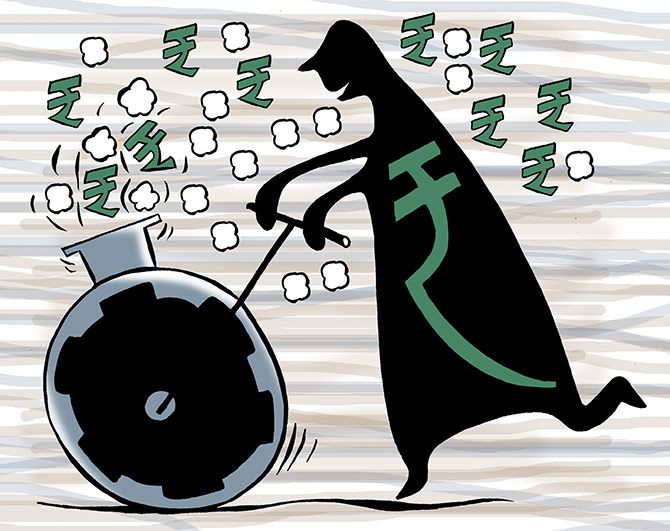A well-established tax system would have a predictable buoyancy - how fast the collections grow as a proportion to the growth of the economy. But that is not the case with GST.
It is still undergoing substantial changes as the government responds to structural as well as administrative glitches.
Nitin Sethi & Abhishek Waghmare report.
Illustration: Uttam Ghosh/Rediff.com

The Union government rationalised its expectations for tax revenue collection in FY20 while presenting the Budget.
Instead of the projected collections in the interim Budget of Rs 25.52 trillion, the Budget on Friday pegged the government’s gross tax revenues at Rs 24.62 trillion.
A large part of this lowered revenue expectation came from reducing the Centre’s targeted revenue from the Goods and Services Tax (GST).
The target for FY20 was brought down from the interim Budget figure of Rs 7.61 trillion to Rs 6.63 trillion.
Every expert agrees the new target is more reasonable compared to the interim Budget numbers. But is it still too ambitious?
Yashodhan Parande, senior advisor for indirect taxes at Deloitte, says, “This is certainly a more reasonable target. Is it still ambitious?
"Compared to the provisional actual numbers, there is still a high expectation.
"It depends on the underlying assumptions the government has made on growth of economy and improvement in compliance levels contributing to rise in GST collections. There are several variables at play currently.”
GST, introduced in FY18, has had a turbulent period so far and is yet to stabilise.
A well-established tax system would have a predictable buoyancy - how fast the collections grow as a proportion to the growth of the economy.
But that is not the case with GST.
It is still undergoing substantial changes as the government responds to structural as well as administrative glitches.
The underlying assumptions of what would ensure a revenue neutral transition from the previous indirect tax regime and how growth of states’ GST revenues would stabilise over five years are all still up for questioning.
Ignoring these complications temporarily, one would first compare the target for FY20 with the collections for FY19.
The Budget document sticks with the revised estimates to say Rs 5.04 trillion was collected as central goods and services tax (CGST).
But the Economic Survey tells us that the Comptroller and Auditor General (CAG) has computed the provisional actuals of overall net tax revenues for FY19 to be much lower.
While it doesn’t give the exact numbers for provisional actual GST, if one was to maintain the same ratio between net tax revenues and CGST, the provisional actual collection of CGST would be pegged at Rs 4.06 trillion - a substantial Rs 97,979 crore less than the revised estimates the Budget uses.
This number reflects CGST after the interstate goods and services tax (IGST) for the year has been reconciled for the year into central and state coffers.
It means the government even now expects the CGST collections to grow this year by a whopping 29.58 per cent.
The other simple parameter is to see how the collections have done between March and June so far.
The CGST collections for the first quarter of FY20 amounted to Rs 33,257 crore per month on an average.
This is on the higher side than the actual. It includes the seasonal spike that collections witness in April and does not account for the refunds to be set-off for June.
Compared to this, the asking rate now is Rs 47,358 crore per month on an average for the rest of the nine months.
This is 42 per cent higher than the existing average for the first quarter - plausible but uphill believe experts.
Kotak Institutional Equities Research noted, “The government’s estimates for central GST, IGST and compensation cess imply about Rs 12.7 trillion of total GST collections.
"This translates into Rs 1.06 trillion monthly run-rate, which is meaningfully higher than the monthly run-rate of about Rs 89,100 crore based on collections for three months of FY20.”
Finance ministry officials told Business Standard that there were specific reasons for low numbers in the first quarter of FY20.
“The fact that the 28 per cent slab included more items in Q1 FY19 than in Q1 FY20, we expected some dip in growth this quarter.
"But growth will improve along the year as it will be on low base, and on the projection that economic activity will revive,” said an official.
Another official said that Q1 FY20 also led to general elections slowing down public investment activity and stalling new tenders.
“Rate stabilisation is an imperative. The catalyst is compliance, which has witnessed improvement in the April to June quarter,” he added.
For a tax system that had stabilised, this would still be a predictable exercise.
But uncertainty haunts both the compliance mechanism and GDP growth.
With the government projecting a healthy rise in GDP, experts presume it has hitched the hope on good GST collections to this underlying growth.
The Budget notes, “Nominal GDP for 2019-20 is expected to be Rs 211 trillion which indicates a nominal growth rate of 12 per cent over the previous year.”
But on tax buoyancy, the Budget is not very optimistic.
It notes, as part of the Medium Term Fiscal Policy-cum-Policy Strategy Statement, “For the financial years 2020-21 and 2021-22, GST is expected to have a buoyancy of 1.0 with respect to nominal GSP growth rates of the respective years.”
In other words, the government, too, does not see a great leap in compliance soon - tax collections will grow at the same rate as GDP, the government predicts.
Officials speaking off the record agreed that collections at this unstable stage of GST depend on compliance improvement beyond just number of returns being filed.
“We are seeing a large leakage because of input credit scams. One part of this is structural. We have not activated the reverse charge mechanism for all.
"It’s a politically fraught decision because it will impact the trading community most. But it could stem the leakages partially and increase revenues,” said one official.
He pointed to data on how GST revenue from businesses with turnover of below Rs 1 crore was providing below 9 per cent of the total GST revenue.
Parande added, “The GST system will take some more time to stabilise. We will only come to know soon how the new set of returns improve compliance.
"Changes in how input credit is accounted for to reduce leakages would also impact CGST and SGST collections.”
He was referring to the flexibility provided recently to adjust input credit against different streams of GST.
This will have some impact on how much cash is collected against CGST compared to SGST after businesses set off standing input credit on their ledgers.
The former has been lagging in terms of cash collections so far.
Another senior official said, “We are beginning to learn what optimum revenue we should be getting from key sector chains at a certain size of activity.
"The rapid changes in the system do not allow us to make temporal comparisons.
"Say, what the optimum levels of input credit should be standing in a certain chain and how much should be coming in as cash.
"Answering questions like this through analytics will help improve compliance.”












 © 2025
© 2025